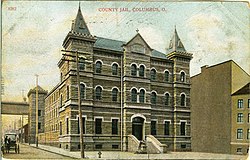
Franklinton is a neighborhood in Columbus, Ohio, just west of its downtown. Settled in 1797, Franklinton is the first American settlement in Franklin County, and was the county seat until 1824. As the city of Columbus grew, the city annexed and incorporated the existing settlement in 1859. Franklinton is bordered by the Scioto River on the north and east, Harmon Avenue on the east, Stimmel Road and Greenlawn Avenue on the south, and Interstate 70 on the west. Its main thoroughfare is West Broad Street, one of the city's two main roads.

Columbus City Schools, formerly known as Columbus Public Schools, is the official school district for the city of Columbus, Ohio, and serves most of the city. The district has 46,686 students enrolled, making it the largest school district in the state of Ohio as of June 2021. At its peak during the 1971 school year the district served 110,725 students.

The Washington County Courthouse in Hillsboro, Oregon is the courthouse for Washington County, Oregon, in the United States. Washington County was established in 1843 and the first government building was finished in 1852. The current courthouse was built in 1928 with an addition and renovations to the structure in 1972. Currently the building houses courtrooms, the county sheriff's dispatch, staff offices, and the office of the district attorney. The county jail was previously attached to the courthouse.
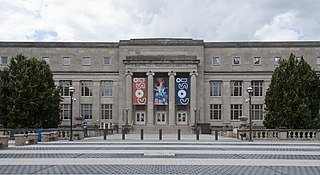
Central High School, also known as High School of Columbus and High School of Commerce, was a four-year secondary school located in Franklinton, Columbus, Ohio. It was a part of Columbus City Schools. On March 7, 1985, the 1924 school building was added to the National Register of Historic Places. It is considered part of the Columbus Civic Center Historic District.
The following is a timeline of the history of the city of Columbus, Ohio, United States.
Prindle, Patrick and Associates was an architectural firm founded by architect Theodore Hord Prindle in 1957 as Titus & Prindle. The firm designed a wide range of buildings, but specialized in jails, prisons, and other correctional facilities. Its most notable projects include the Municipal Court, Hall of Justice, jail, and courthouse annex at the Franklin County Government Center in Columbus, Ohio, and the courthouse, jail, and county sheriff headquarters at the Justice Center Complex in Cleveland, Ohio. The firm dissolved in 1991.
Columbus, the capital city of Ohio, was founded on the east bank of the Scioto River in 1812. The city was founded as the state's capital beside the town of Franklinton, since incorporated into Columbus. The city's growth was gradual, as early residents dealt with flooding and cholera epidemics, and the city had few direct connections to other cities. This encouraged creation of a feeder canal, and later, freight and passenger railroads. The city became known for its industry and commercial businesses in the 20th century, though it experienced a lull in development in the late 20th century. In the 21st century, Columbus has been increasingly revitalized due to parks projects, new developments, and efforts to beautify individual neighborhoods.

The Toledo and Ohio Central Railroad Station, today named Station 67, is a union meeting space and event hall located in Franklinton, near Downtown Columbus, Ohio. Built by the Toledo and Ohio Central Railroad from 1895 to 1896, it served as a passenger station until 1930. It served as an office and shelter for Volunteers of America from 1931 to 2003, and has been the headquarters of International Association of Fire Fighters Local 67, a firefighters' union, since 2007. The building was placed on the National Register of Historic Places in 1973. During its history, the building has experienced fires and floods, though its relatively few owners have each made repairs and renovations to preserve the building's integrity. The building is the last remaining train station in Columbus.

Dorrian Commons Park was a park and part of the Franklin County Government Center in downtown Columbus, Ohio, United States. The park opened in 1976 on the site of the first and second Franklin County Courthouse, built in 1887. Dorrian Commons closed in 2018, pending construction of a new courthouse.

Capitol Square is a public square in Downtown Columbus, Ohio. The square includes the Ohio Statehouse, its 10-acre (4.0 ha) Capitol Grounds, as well as the buildings and features surrounding the square. The Capitol Grounds are surrounded to the north and west by Broad and High Streets. These are the main thoroughfares of the city since its founding. They form the city's 100 percent corner. The grounds are surrounded by 3rd Street to the east and State Street to the south. The oldest building on Capitol Square, the Ohio Statehouse, is the center of the state government and roughly in the geographic center of Capitol Square, Columbus and Ohio.

The Columbus Civic Center is a civic center, a collection of government buildings, museums, and open park space in Downtown Columbus, Ohio. The site is located along the Scioto Mile recreation area and historically was directly on the banks of the Scioto River.
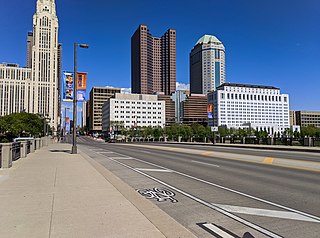
Broad Street is a major thoroughfare in Central Ohio, predominantly in Franklin County and Columbus. It stretches east from West Jefferson at Little Darby Creek to Pataskala. The street is considered one of Columbus's two main roads, along with High Street.

Central Market was a public market in Downtown Columbus, Ohio. The market operated from 1814 to 1966, was the location of Columbus's first city hall for two decades, from 1850 to 1872. It moved three times, each time into successively larger buildings. The third market building stood the longest time, from 1850 to 1966, when it was demolished as part of the Market-Mohawk Urban Renewal project. North Market remains, the only one left of four public markets that operated in the city.
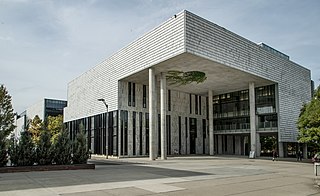
The architecture of Columbus, Ohio is represented by numerous notable architects' works, individually notable buildings, and a wide range of styles. Yost & Packard, the most prolific architects for much of the city's history, gave the city much of its eclectic and playful designs at a time when architecture tended to be busy and vibrant.

The 1887 Franklin County Courthouse was the second permanent courthouse of Franklin County, Ohio. The building, located in the county seat of Columbus, stood from 1887 to 1974. It replaced a smaller courthouse on the site, extant from 1840 to c. 1884. The 1887 courthouse deteriorated over several decades, and the site was eventually replaced with Dorrian Commons Park, open from 1976 to 2018; the court moved to a new building nearby. As of 2020, the site is planned to once again hold the county's Municipal Court building.
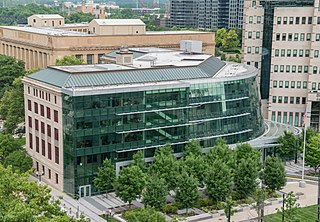
77 North Front Street is a municipal office building of Columbus, Ohio, in the city's downtown Civic Center. The building, originally built as the Central Police Station in 1930, operated in that function until 1991. After about two decades of vacancy, the structure was renovated for city agency use in 2011.

The 1840 Franklin County Courthouse was the first permanent courthouse of Franklin County, Ohio in the United States. The building, located in the county seat of Columbus, stood from 1840 to 1884. The building was replaced with another county courthouse in 1887, and after its demise, that courthouse was replaced with Dorrian Commons Park, open from 1976 to 2018; the courthouse moved to a new building nearby. The site is now planned to host the Franklin County Municipal Court.

The American Education Press Building was an office and industrial building in Downtown Columbus, Ohio. It was designed by Richards, McCarty & Bulford in the Streamline Moderne style, with rounded corners, a flat roof, and its exterior and interior walls predominantly made from glass blocks, a new innovation in the 1930s.

The Columbus City Prison was a municipal prison in Downtown Columbus, Ohio. The building was constructed in 1879 in a castle-like style, designed by architect George H. Maetzel. The building served as a prison and headquarters of the Columbus Police Department until a fire demolished the structure in 1920.
